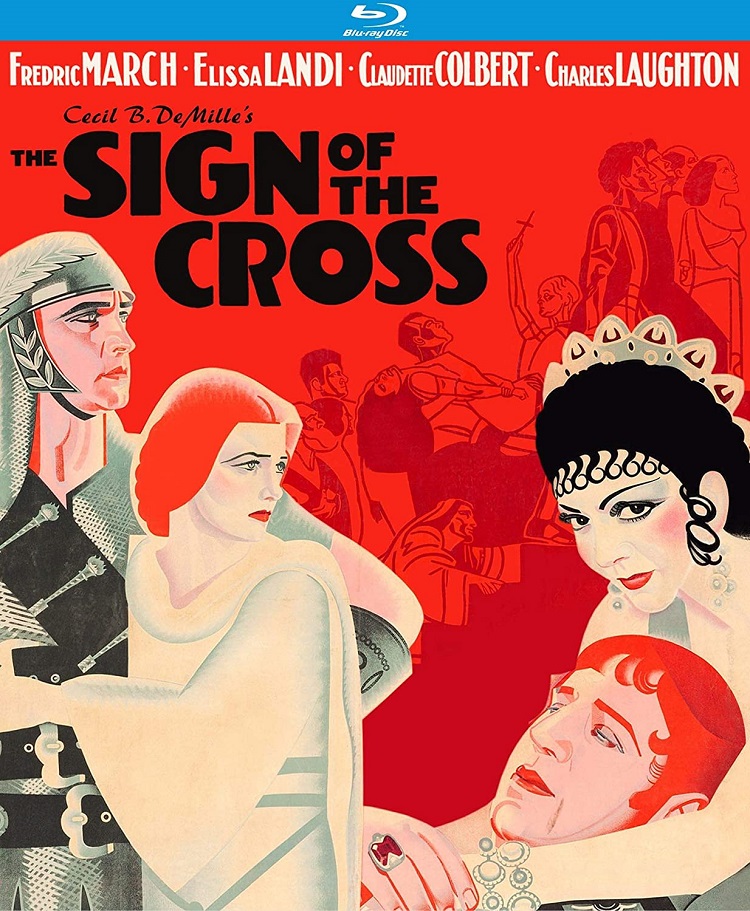
Claudette Colbert naked in a bath filled donkey’s milk. Well, topless at least. And the milk was powdered cow’s milk mixed with water. The heat of the lights soured it, so that the stench filled the stage. It must have been misery for Colbert. But god, is it sexy as hell. It is one of the most infamous scenes in a pre-Code movie. It is tame by today’s standards, but again that eroticism is something else. The scene does have a reason to exist beyond sex appeal. Colbert is playing Empress Poppaea, the wife of Roman Emperor Nero. Outside, we see at least a dozen donkeys being milked into buckets which are then lifted and poured into a hole. Inside, the milk slides down and comes out of a statue’s mouth, pouring into the large, luxurious, marble bath. The Empress is being waited on by several servants. A woman comes in to bring her news and the Empress commands her to undress and get inside the tub. The entire scene is designed to show how hedonistic, how sinful the Empress, and thus the entire Roman people lived. This will be contrasted with the piety and goodness of Christians living at the same time.
The Sign of the Cross, Cecil B. DeMille’s 1932 epic, is a film of contrasts. It was a huge box-office hit, but outraged morality groups like the Catholic Legion of Decency and was one of the films credited with forcing the enactment of the Hayes Code. It is a film about Christian love and decorum that makes lust and debauchery look so enticing. It looks like an extraordinarily expensive epic but was made on a budget. This is but some of the many reasons I’m starting to love pre-Code films: anything can happen.
The Empress is in love with one of Nero’s top men, Marcus Superbus (Frederic March), who has been charged with rounding up Christians for the slaughter in the Coliseum. One day, two men are caught marking a picture of the cross in the dirt and are brought before Marcus. Before he can pass judgment, a beautiful woman, Mercia (Elissa Landi), rushes in and begs for mercy. Marcus is immediately smitten and lets the men go. Later, he visits Mercia at a well (no doubt alluding to the famous Biblical story of Jesus meeting a woman at a well). They talk awhile. It is a scene filled with sexuality and power. DeMille blocks it magnificently. Marcus struts over to her; she demures. She tries to escape up a staircase; he chases after her. Whenever he has the upper hand, he stands tall, several steps above her. But then she’ll maneuver herself up a few steps while demonstrating her own inner courage. The power struggle is literally played out visually.
He visits her home. He seems to know that her family are Christians but does his best to pretend otherwise. Or else, he’d have to do his duty and arrest them. He’s far too infatuated for that. Another Roman soldier, Tigellinus (Ian Keith), vying for Marus’ place with Nero, connives to prove Mercia and her friends are Christians. He grabs a young boy and tortures him to find out where the Christians will be meeting. Meanwhile, the Empress also plots against Mercia in order to win back Marcus’ love.
Nero is performed with great relish by Charles Laughton. Rather than play him as a purely evil, tyrannical dictator, Laughton gives him an overtly sexualized flamboyance who keeps a harem of naked men and women at his feet while he plays the harp and sings as Rome burns. Couple that with Colbert’s gleeful hedonism and it takes what is mostly a very serious dramatic film and turns it camp.
Another famous scene involves a female dancer trying to seduce Marcia. Surrounded by admirers, the dancer sings while moving her hips seductively in an outfit that could be generously described as “barely there,” all while touching and kissing Marcia. Outside, a group of Christians sing a hymn as they are marched towards their death. The juxtaposition is wildly entertaining.
For the first two acts, I found The Sign of the Cross to be a fairly interesting little drama. The set design is fantastic. Apparently, DeMille borrowed from other productions and added in new designs to create a series of sets that look like a million bucks. Great halls and dingy dungeons come to life with excellent lighting and design choices. The contrast between the wild Romans and the chaste Christians is fascinating and the love story kept my attention. But then for its last act, it takes a turn. The Christians are caught and taken to the Coliseum for execution. DeMille’s love of spectacle comes out in full to the detriment of the story. Gladiators fight one another. Little people battle large women. Bears, lions, and alligators chomp down on naked women (with strategically placed flowers covering their naughty bits). Heads literally roll. It must have been shocking 70 years ago. It is still pretty shocking watching it today, actually. But it also goes on for far too long. I don’t mind a little spectacle, but 20 minutes of it with very little story getting in its way is more than I need.
The Sign of the Cross is an utterly fascinating film. It crosses all sorts of lines that Hollywood movies wouldn’t be able to cross again in a few years until the Hayes Code was destroyed several decades later. It is designed as a religious film but celebrates sexuality, drunkenness, and violence. It is a film one can’t quite believe got made in 1932.
Kino Lorber’s transfer looks quite good for a film this old. Extras include two audio commentaries – one by Mark A Vieira, who wrote a book on DeMille, and another by film historian David Del Valle. It also includes trailers to other Kino Lorber releases.